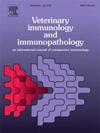极化猪单核细胞衍生巨噬细胞亚群中关键免疫基因的表达。
IF 1.4
3区 农林科学
Q4 IMMUNOLOGY
引用次数: 0
摘要
猪被认为是最相关的大型动物生物医学模型之一,因为它们在免疫学方面与人类有许多相似之处。尽管如此,猪的巨噬细胞极化尚未得到全面研究。在这项研究中,猪单核细胞衍生巨噬细胞(moMΦ)未经处理,或受到 IFN-γ + LPS(经典激活)刺激,或受到不同的 M2 极化刺激:IL-4、IL-10、TGF-β 或地塞米松。研究了巨噬细胞亚群中关键细胞因子基因(IL1B2、IL33、IL19、IL22、IL26、CCL17、CCL24、IFNA、IFNB)随时间变化的表达情况。此外,还评估了编码精氨酸通路两种主要酶(ARG1、NOS2)的基因的表达情况,以及与人和小鼠巨噬细胞替代极化有关的分子(MMP9、MRC1、FIZZ1、VEGFA)的表达情况。IFN-γ+LPS刺激可引发IL1B2、IFNB、NOS2的上调,而IL-4可引发CCL17、CCL24、CXCR2和ARG1表达的上调。IL19和IL22的表达在IFN-γ + LPS或TGF-β的刺激下会增强,但在IL-4、IL-10或地塞米松的刺激下不会增强。我们的数据突显了猪的一些特殊性,如在受到 IFN-γ + LPS 刺激后,IL33 的表达被诱导,而在受到任何 M2 极化刺激后,FIZZ1、VEGFA 或 MMP9 都没有上调。更好地了解猪巨噬细胞的极化过程将有利于利用这种大型动物模型进行转化研究。本文章由计算机程序翻译,如有差异,请以英文原文为准。
Expression of key immune genes in polarized porcine monocyte-derived macrophage subsets
Swine are considered one of the most relevant large animal biomedical models since they share many immunological similarities with humans. Despite that, macrophage polarization has not comprehensively investigated in pigs. In this study, porcine monocyte-derived macrophages (moMΦ) were untreated or stimulated with IFN-γ + LPS (classical activation), or by different M2 polarizing stimuli: IL-4, IL-10, TGF-β, or dexamethasone. Expression of key cytokine genes (IL1B2, IL33, IL19, IL22, IL26, CCL17, CCL24, IFNA, IFNB) in macrophage subsets were investigated over time. Expression of the genes encoding the two main enzymes of the arginine pathway (ARG1, NOS2), and molecules related to alternative macrophage polarization in human and mice (MMP9, MRC1, FIZZ1, VEGFA) were also assessed. Stimulation with IFN-γ + LPS triggered up-regulation of IL1B2, IFNB, NOS2, whereas IL-4 triggered upregulation of CCL17, CCL24, CXCR2, and ARG1 expression. IL19 and IL22 expression was enhanced by stimulation with IFN-γ + LPS or TGF-β, but not IL-4, IL-10, or dexamethasone. Our data highlighted some peculiarities in swine, such as induced expression of IL33 after stimulation with IFN-γ + LPS, and no up-regulation of FIZZ1, VEGFA or MMP9 after exposure to any of the M2 polarizing stimuli. A better understanding of porcine macrophage polarization could benefit translational studies using this large animal model.
求助全文
通过发布文献求助,成功后即可免费获取论文全文。
去求助
来源期刊
CiteScore
3.40
自引率
5.60%
发文量
79
审稿时长
70 days
期刊介绍:
The journal reports basic, comparative and clinical immunology as they pertain to the animal species designated here: livestock, poultry, and fish species that are major food animals and companion animals such as cats, dogs, horses and camels, and wildlife species that act as reservoirs for food, companion or human infectious diseases, or as models for human disease.
Rodent models of infectious diseases that are of importance in the animal species indicated above,when the disease requires a level of containment that is not readily available for larger animal experimentation (ABSL3), will be considered. Papers on rabbits, lizards, guinea pigs, badgers, armadillos, elephants, antelope, and buffalo will be reviewed if the research advances our fundamental understanding of immunology, or if they act as a reservoir of infectious disease for the primary animal species designated above, or for humans. Manuscripts employing other species will be reviewed if justified as fitting into the categories above.
The following topics are appropriate: biology of cells and mechanisms of the immune system, immunochemistry, immunodeficiencies, immunodiagnosis, immunogenetics, immunopathology, immunology of infectious disease and tumors, immunoprophylaxis including vaccine development and delivery, immunological aspects of pregnancy including passive immunity, autoimmuity, neuroimmunology, and transplanatation immunology. Manuscripts that describe new genes and development of tools such as monoclonal antibodies are also of interest when part of a larger biological study. Studies employing extracts or constituents (plant extracts, feed additives or microbiome) must be sufficiently defined to be reproduced in other laboratories and also provide evidence for possible mechanisms and not simply show an effect on the immune system.

 求助内容:
求助内容: 应助结果提醒方式:
应助结果提醒方式:


